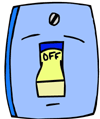Dear Umbra,
You’d be so proud of us! We just had an hour-long meeting about conservation and environmentalism here in our office. In the course of our discussion, the topic of leaving the lights on came up. I am a religious light-switcher, meaning I turn lights off in the bathroom or wherever they’re left on. One of my colleagues was under the impression that it takes more energy to turn fluorescent lights on and off than it does to leave them on. I’m shocked! Is this true? And are there eco-sensitive alternatives to standard fluorescent tubes?
In the dark,
Matt
San Francisco, Calif.
Dearest Dark,
Here’s a simple rule to remember whenever the lights-on/lights-out controversy pops up: Think of Lady Macbeth. Out! Out!

The brilliant Anne Ducey, residential lighting program coordinator at Seattle City Light, laughed with delight when I asked her to settle this debate once and for all. Here’s her unflinching bottom line: Turn out the lights if you are the last to leave a room, unless you are coming back within two minutes. Contrary to popular belief, turning lights on consumes no more electricity than they use when already lit. This is true for both fluorescent and incandescent bulbs. Out! Out!
Fluorescent lights do have a finite number of starts built into the “ballast,” the mechanism in the bulb that translates electricity into illumination, and another reader wrote in concerned about wearing them out. But in order to wear out the starts before the rest of the bulb burned out, you would need to turn your lights on and off 20-50 times a day — or, as Anne put it, you’d have to have 20,000 cats run past the motion sensor in your backyard. So. Out! Even in the office bathroom.

I’m not sure whether you want to replace your standard fluorescent tubes for environmental or aesthetic reasons. If it’s the former, don’t; they are highly efficient and hence a good option for the environment. If it’s the latter — that is, if you don’t like the quality of light they cast — you may have old light fixtures that reflect light poorly, or you may just have older fluorescent tubes that have been up there forever (because they’re so efficient, remember?). Modern fixtures and well-chosen tubes should result in well-lit, warm, energy-efficient spaces.
That leads me to the other earth-shattering revelation Anne Ducey shared with me when I spoke with her about lighting controversies. Are you sitting down? “Full spectrum” lighting is a marketing hoax. This evocative phrase, used by marketers to imply a grievous lack of spectrum fullness in other, inferior products, is a red herring. All typical household bulbs emit all the colors of the spectrum, although they may differ in the amount of one color or another they emit. The two ways to measure light quality are in degrees Kelvin and using the Color Rendering Index (CRI), neither of which has anything to do with the fullness of the color spectrum. According to Anne, those “full spectrum” gadgets have never been proven to have any particular benefit. The placebo effect, on the other hand, is one of the most powerful tools known to humanity.
Brightly,
Umbra

